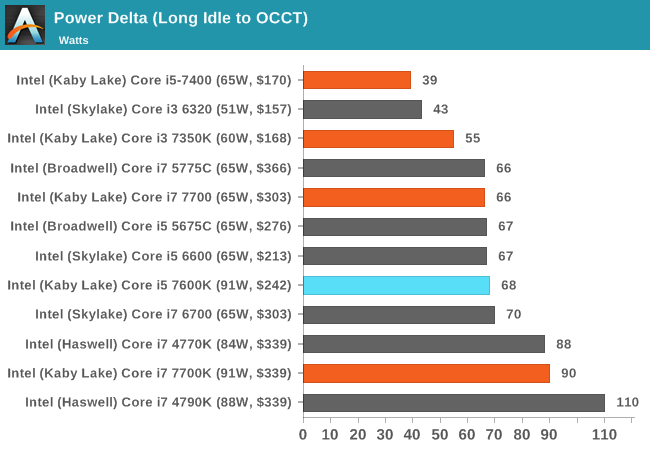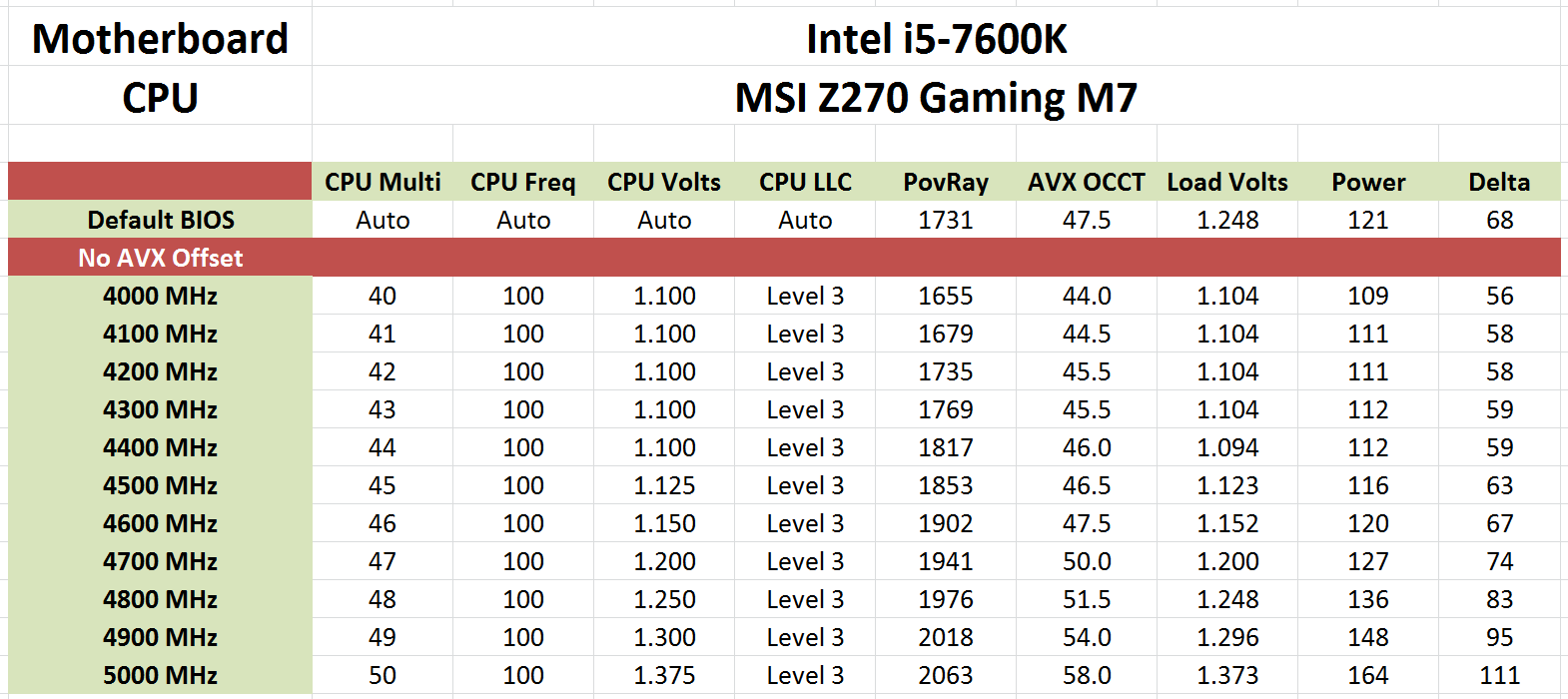The Intel Core i5-7600K (91W) Review: The More Amenable Mainstream Performer
by Ian Cutress on January 3, 2017 12:01 PM ESTPower Consumption
As with all the major processor launches in the past few years, performance is nothing without a good efficiency to go with it. Doing more work for less power is a design mantra across all semiconductor firms, and teaching silicon designers to build for power has been a tough job (they all want performance first, naturally). Of course there might be other tradeoffs, such as design complexity or die area, but no-one ever said designing a CPU through to silicon was easy. Most semiconductor companies that ship processors do so with a Thermal Design Power, which has caused some arguments recently based presentations broadcast about upcoming hardware.
Yes, technically the TDP rating is not the power draw. It’s a number given by the manufacturer to the OEM/system designer to ensure that the appropriate thermal cooling mechanism is employed: if you have a 65W TDP piece of silicon, the thermal solution must support at least 65W without going into heat soak. Both Intel and AMD also have different ways of rating TDP, either as a function of peak output running all the instructions at once, or as an indication of a ‘real-world peak’ rather than a power virus. This is a contentious issue, especially when I’m going to say that while TDP isn’t power, it’s still a pretty good metric of what you should expect to see in terms of power draw in prosumer style scenarios.
So for our power analysis, we do the following: in a system using one reasonable sized memory stick per channel at JEDEC specifications, a good cooler with a single fan, and a GTX 770 installed, we look at the long idle in-Windows power draw, and a mixed AVX power draw given by OCCT (a tool used for stability testing). The difference between the two, with a good power supply that is nice and efficient in the intended range (85%+ from 50W and up), we get a good qualitative comparison between processors. I say qualitative as these numbers aren’t absolute, as these are at-wall VA numbers based on power you are charged for, rather than consumption. I am working with our PSU reviewer, E.Fylladikatis, in order to find the best way to do the latter, especially when working at scale.
Nonetheless, here are our recent results for Kaby Lake at stock frequencies:

The Core i5-7600K, despite the 91W TDP rating, only achieved 63W in our power test. This is relatively interesting, suggesting that the Core i5 sits in a good power bracket for voltage (we see that with overclocking below), but also the mixed-AVX loading only starts piling on the power consumption when there are two hyperthreads going for those instructions at the same time per core. When there’s only one thread per core for AVX, there seems to be enough time for each of the AVX units to slow down and speed back up, reducing overall power consumption.
Overclocking
At this point I’ll assume that as an AnandTech reader, you are au fait with the core concepts of overclocking, the reason why people do it, and potentially how to do it yourself. The core enthusiast community always loves something for nothing, so Intel has put its high-end SKUs up as unlocked for people to play with. As a result, we still see a lot of users running a Sandy Bridge i7-2600K heavily overclocked for a daily system, as the performance they get from it is still highly competitive.
There’s also a new feature worth mentioning before we get into the meat: AVX Offset. We go into this more in our bigger overclocking piece, but the crux is that AVX instructions are power hungry and hurt stability when overclocked. The new Kaby Lake processors come with BIOS options to implement an offset for these instructions in the form of a negative multiplier. As a result, a user can stick on a high main overclock with a reduced AVX frequency for when the odd instruction comes along that would have previously caused the system to crash.
We used the AVX Offset option when we overclocking the Core i7-7700K and achieved another 100-200 MHz extra frequency for non-AVX before succumbing to overheating. Ultimately that’s not a lot of frequency, but that can be enough for some users. With the Core i5-7600K, we got a great result without even touching the AVX offset option:
Straight out of the box, our retail sample achieved an OCCT stable 5.0 GHz with mixed AVX at a 1.375V setting, with the software recording only 58C peak on the core and a maximum power draw of 111W. That’s fairly astonishing – from the base 3.8/4.2 GHz we were able to get up to 800 MHz in an overclock for just under double the power draw (or, +20W over TDP).











70 Comments
View All Comments
Obviously Dead - Wednesday, July 26, 2017 - link
Depends. For me it's the best yet, since I'm upgrading from an E5400.Dr. Swag - Tuesday, January 3, 2017 - link
Hey Ian, where's the 6700k in these benchmarks? It's in the 7700k review but not the 7600k review :/Bullwinkle J Moose - Tuesday, January 3, 2017 - link
What benefit does this bring to me?A fresh install of Windows XP-SP2 boots in 3 seconds on my 35 watt Sandy Bridge
I can block NSA and FBI malware on XP but not on Windows Spyware Platform 10
For audio production, I can record what I hear in XP but not in 7/8 or 10
I can still boot to 10 if I want malware and spyware relabeled as DRM but I haven't had a Blue Screen of death in over 10 years now with XP-SP2 and I do not get persistent malware, so......
What's the point of getting this new chip ?
Why pay more to be limited as to what I can do with "MY" computer?
I'm not trolling
It's a serious question
So answer it honestly without the attacks (Crayons)
Why downgrade to an OS that limits what you can do on a hardware platform that also limits what you can run?
Eletriarnation - Tuesday, January 3, 2017 - link
If you're running Windows XP on Sandy Bridge, it's my guess that Intel isn't really targeting your use case and maybe you shouldn't be surprised that you see no benefit in upgrading.Murloc - Tuesday, January 3, 2017 - link
if you are so concerned with this stuff and security, why don't you use open source software so you can be sure of what it does?Then you'd be able to get all the benefits of modern OSes (which are many compared to XP) without the spyware.
Ninhalem - Tuesday, January 3, 2017 - link
Just stop. You're trolling. This is the same comment in the Kaby Lake i7 article. Your usage scenario is beyond minuscule compared to every other mainstream and enterprise system.Bullwinkle J Moose - Wednesday, January 4, 2017 - link
NinhalemPresenting FACTS regarding these chips and how they can and cannot be used is not trolling
I can provide all the evidence needed to show anyone how to lock down XP to a VERY secure state
I cannot do the same for Windows 7/8 or 10 due to the malware and spyware that Microsoft calls DRM to get around the Law for the purpose of committing what are considered Very serious crimes if done by you or me
If you wish to reproduce my results, I can show you how but this is NOT trolling
Only negative responses to my posts without any evidence or effort given to reproduce my results are from Trolls
Read replies by Crayons for trolling examples
He is a Pro!
lopri - Wednesday, January 4, 2017 - link
You piqued my interest. Is there something I can look up as to how to lock down XP to a secure state?jimbo2779 - Wednesday, January 4, 2017 - link
The power button is quite useful for keeping XP secure.Seriously though, the guy is trolling, to what ends I do not know, but his use case apparently has no need for any of the multitude of improvements brought in from vista onwards.
From what I gather from all his posts all he wants to do is test malware and prove his locked down XP is secure. Personally I use my system for much more and don't remember the last ti.e I caught any kind if malware infection so have no need to stay shackled by an out dated OS.
To each their own I guess
Bullwinkle J Moose - Wednesday, January 4, 2017 - link
lopriIs there something I can look up as to how to lock down XP to a secure state?
--------------------------------------------------------------------------------------------------------
yes, you can read my posts and try what I have done for yourself so you have your own evidence instead of believing the majority voice at every turn and finding your computer can never be secured
or, you can choose to believe Microsoft and continue to think that DRM opening backdoors into your system is a good thing and is keeping you safe by watching everything you do to ....
A. Protect You?
or
B. Protect a Monopoly that cannot be overturned because protecting MY right to privacy is in direct violation of the Laws the Monopoly created to prevent me from defeating "their" DRM
I say it is B.
The only way they can survive is by preventing me from doing what they are doing ensuring their own survival at my expense
I do not recognize their (your) Laws or their (your) License
I will continue to violate any Law or License that grants anyone rights that they choose to deny me
So to humor me for the Lulz is a waste of time
but you already knew that